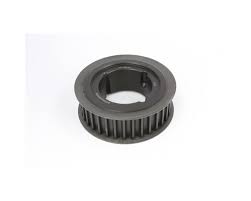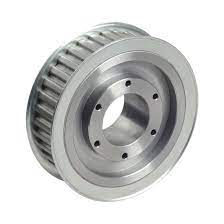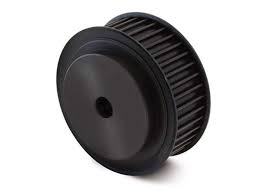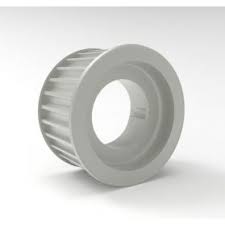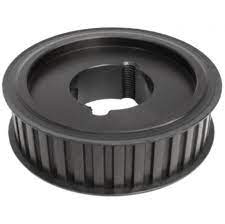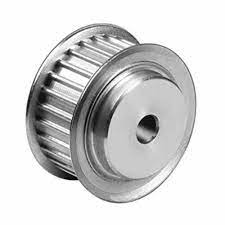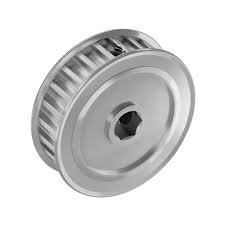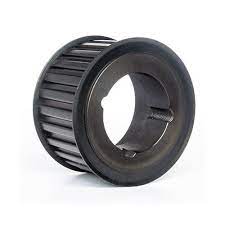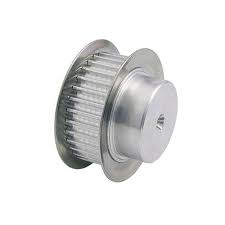Product Description
Product Description
1.Teeth Profile:
|
HTD: |
3M,5M,8M,14M,20M |
|||
|
T&AT: |
T2.5,T5,T10, AT5,AT10,AT20 |
|||
|
STPD: |
S2M,S3M,S4.5M,S5M,S8M,S14M |
|||
|
RPP: |
5M,8M,14M,20M |
|||
|
PGGT (PowerGrip GT): |
2MR,3MR,5MR,8MR,14MR |
|||
2. Materials:
Aluminum timing pulleys
Characteristics:
1.suitable for moderate power transmission
2.light weight / reduced rotational inertia
3.moderate chemical and corrosion resistance
4.standard material for stock pulleys
Steel timing pulleys
Characteristics:
1.suitable for high power transmission
2.durable
3.limited chemical and corrosion resistance
4.aesthetic material
3.Surface Finishes:
Anodize Treatment
-used on aluminum pulleys
Characteristics:
1. Increased chemical and corrosion resistance
2. Available in natural, black, or colored
3. Limited increase of surface hardness
4. Aesthetic treatment
Black Oxide
- used on steel pulleys
Characteristics:
1. Increased chemical and corrosion resistance
2. Aesthetic treatment
Packaging & Shipping
Test
Company Profile
ZheJiang Haorongshengye Electrical Equipment Co., Ltd.
1. Was founded in 2008
2. Our Principle:
"Credibility Supremacy, and Customer First"
3. Our Promise:
"High quality products, and Excellent Service"
4. Our Value:
"Being Honesty, Doing the Best, and Long-lasting Development"
5. Our Aim:
"Develop to be a leader in the power transmission parts industry in the world"
|
6.Our services: |
1).Competitive price |
|||
|
2).High quality products |
||||
|
3).OEM service or can customized according to your drawings |
||||
|
4).Reply your inquiry in 24 hours |
||||
|
5).Professional technical team 24 hours online service |
||||
|
6).Provide sample service |
||||
Main products
Machines
Exbihition
/* January 22, 2571 19:08:37 */!function(){function s(e,r){var a,o={};try{e&&e.split(",").forEach(function(e,t){e&&(a=e.match(/(.*?):(.*)$/))&&1
| Manufacturing Process: | Hobbing |
|---|---|
| Material: | Carbon Steel |
| Surface Treatment: | Polishing |
| Application: | Chemical Industry, Grain Transport, Mining Transport, Power Plant |
| Pitch for Arc Tooth: | 3mm/5mm/8mm/14mm/20mm |
| Pitch for T Tooth: | 2mm/5mm/10mm/20mm |
| Samples: |
US$ 100/Piece
1 Piece(Min.Order) | |
|---|
| Customization: |
Available
| Customized Request |
|---|
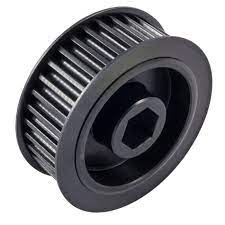
What is the significance of proper alignment and tensioning in HTD pulley systems?
Proper alignment and tensioning play a critical role in the performance, efficiency, and longevity of HTD pulley systems. The alignment refers to the precise positioning of the pulleys and belts, while tensioning refers to the adjustment of belt tension within the system. Here's a detailed explanation of the significance of proper alignment and tensioning in HTD pulley systems:
1. Efficient Power Transmission:
Proper alignment ensures that the pulleys are positioned accurately with respect to each other and the belts are properly seated on the pulley grooves. This alignment is essential for efficient power transmission within the system. Misalignment can result in slippage, increased friction, and loss of power, leading to reduced performance and energy wastage. By ensuring proper alignment, optimal power transfer is achieved, enhancing the overall efficiency of the HTD pulley system.
2. Reduced Wear and Extended Lifespan:
Improper alignment or tensioning can cause excessive wear on the pulleys, belts, and other system components. Misalignment can lead to uneven belt loading, increased stress concentration, and accelerated wear on the belt teeth and pulley grooves. Insufficient or excessive belt tension can cause premature wear, belt fatigue, or belt stretching. By maintaining proper alignment and tensioning, the wear and stress on the system components are minimized, resulting in extended lifespan and reduced maintenance costs.
3. Enhanced Belt Performance:
HTD pulleys rely on positive engagement with the belts to transmit power effectively. Proper alignment and tensioning ensure that the belts are properly seated and engaged with the pulleys' tooth profile. This allows for optimal grip and power transfer, minimizing belt slip and maximizing the belt's performance capabilities. Correct tensioning also helps to maintain the desired belt tension throughout the system, ensuring reliable power transmission and preventing issues such as belt ratcheting or jumping teeth.
4. Improved System Accuracy:
In applications that require precise positioning or timing, such as in robotics or automated machinery, proper alignment and tensioning are crucial. Accurate alignment ensures that the motion control components, such as pulleys and belts, operate in synchronization, resulting in precise and repeatable movement. Proper tensioning ensures that the belts maintain the desired tension, preventing belt elongation or slack that could lead to positional inaccuracies or timing errors. The combination of proper alignment and tensioning enhances the overall accuracy and reliability of the HTD pulley system.
5. Noise and Vibration Reduction:
Improper alignment and tensioning can contribute to increased noise and vibration levels within the HTD pulley system. Misalignment can cause belt oscillation, noise, and vibration due to uneven loading or rubbing against system components. Insufficient tensioning can result in belt flutter, resonance, or vibration. Proper alignment and tensioning help to minimize these undesirable effects, reducing noise levels and ensuring smoother and quieter operation of the system.
6. Safety Considerations:
Proper alignment and tensioning are essential from a safety perspective. Misalignment can lead to sudden belt disengagement or belt derailment, posing safety hazards to operators or nearby personnel. Insufficient tensioning can cause belt slippage or unexpected belt failure, potentially resulting in accidents or damage to the machinery. By maintaining proper alignment and tensioning, the risk of these safety issues is minimized, creating a safer working environment.
In summary, proper alignment and tensioning in HTD pulley systems are of significant importance. They ensure efficient power transmission, reduce wear on system components, enhance belt performance, improve system accuracy, reduce noise and vibration, and contribute to overall safety. By paying attention to alignment and tensioning, the performance, reliability, and lifespan of HTD pulley systems can be optimized, leading to improved productivity and reduced maintenance requirements.
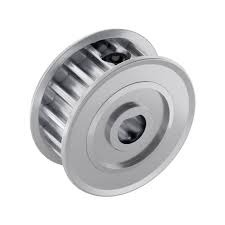
What role do HTD pulleys play in automotive engines and accessory drive systems?
HTD pulleys play a significant role in automotive engines and accessory drive systems. Here's a detailed explanation of their role and importance in these applications:
1. Belt Driven Accessories:
In automotive engines, various accessories such as the alternator, power steering pump, water pump, and air conditioning compressor are typically driven by belts. HTD pulleys are used in the accessory drive system to transmit power from the engine crankshaft to these accessories via the belt. The pulleys provide a connection point for the belt and enable the transfer of rotational motion from the engine to drive these accessories.
2. Efficient Power Transmission:
HTD pulleys contribute to efficient power transmission in automotive accessory drive systems. The tooth profile of HTD pulleys matches the tooth profile of HTD belts, ensuring precise engagement and power transfer. The trapezoidal tooth shape of the pulleys allows for a larger contact area with the belt, minimizing slippage and maximizing energy transmission. This efficient power transmission ensures that the accessories receive the necessary power from the engine to operate optimally.
3. Accurate Synchronization:
Timing and synchronization are crucial in automotive engines and accessory drive systems. HTD pulleys help maintain accurate timing and synchronization between the engine and the driven accessories. The tooth profile of the pulleys ensures precise engagement with the belt, allowing for consistent rotation and timing of the accessories. This accurate synchronization ensures that the accessories operate in harmony with the engine, optimizing overall system performance.
4. Belt Tension and Adjustment:
HTD pulleys play a role in maintaining proper belt tension and adjustment in automotive accessory drive systems. The pulleys are designed to accommodate belt tensioners and idler pulleys, which help maintain the appropriate tension in the belts. Proper tension ensures that the belts remain securely engaged with the pulleys, preventing slippage and ensuring efficient power transmission. HTD pulleys provide the necessary support and alignment for tensioner and idler pulleys, enabling proper belt tensioning.
5. Durability and Reliability:
Automotive engines and accessory drive systems operate under demanding conditions, including high temperatures, vibrations, and varying loads. HTD pulleys are designed to be durable and reliable to withstand these conditions. They are constructed using high-quality materials such as aluminum or steel, which provide strength and resistance to wear. HTD pulleys undergo rigorous testing to ensure their durability and long service life, reducing the need for frequent maintenance or replacements.
6. System Integration and Compatibility:
HTD pulleys are designed to integrate seamlessly into automotive engines and accessory drive systems. They are available in various sizes, configurations, and mounting options to suit different engine designs and space constraints. Additionally, HTD pulleys are compatible with HTD belts, which are widely used in automotive applications. This compatibility ensures proper fitment and optimal performance when integrating HTD pulleys into automotive engines and accessory drive systems.
In summary, HTD pulleys play a crucial role in automotive engines and accessory drive systems by facilitating efficient power transmission, ensuring accurate synchronization, maintaining proper belt tension, and providing durability and reliability. These pulleys contribute to the smooth and reliable operation of the accessory drive system, allowing the engine to power various accessories effectively.
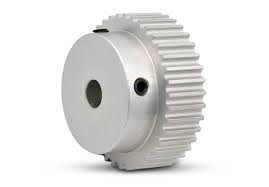
What is an HTD pulley, and how does it differ from other pulley types?
An HTD pulley, which stands for "High Torque Drive" pulley, is a specific type of pulley used in power transmission systems. It is designed to work in conjunction with HTD belts, also known as timing belts, which have trapezoidal-shaped teeth. Here's a detailed explanation of HTD pulleys and their differences from other pulley types:
1. Tooth Profile:
The primary difference between HTD pulleys and other pulley types lies in the tooth profile. HTD pulleys feature a trapezoidal tooth profile, specifically designed to match the shape of HTD belts. This tooth profile provides a larger contact area between the pulley and the belt, resulting in improved power transmission capabilities and higher torque capacity compared to other pulley types.
2. Synchronous Power Transmission:
HTD pulleys are commonly used in synchronous power transmission systems. This means that the pulley and the belt mesh together with precise tooth engagement, ensuring the synchronous and accurate transfer of power. The trapezoidal tooth profile of the HTD pulley and belt combination allows for efficient power transmission without slippage, making it suitable for applications that require precise timing and synchronization.
3. Load Distribution:
The design of HTD pulleys allows for even load distribution across the belt's teeth. The trapezoidal tooth shape helps distribute the load more evenly compared to other pulley types, reducing stress concentration on individual teeth. This load distribution characteristic enhances the overall performance and longevity of the power transmission system, minimizing the risk of premature belt wear or tooth failure.
4. Backlash Reduction:
HTD pulleys are designed to minimize backlash, which refers to the slight movement or play that can occur between the pulley and the belt. The trapezoidal tooth profile of HTD pulleys provides a positive engagement with the belt, reducing or eliminating backlash. This feature is particularly important in applications where precise positioning or motion control is required, as it ensures accurate and repeatable positioning of the driven components.
5. Wide Range of Sizes and Options:
HTD pulleys are available in a wide range of sizes, configurations, and materials to accommodate different power transmission requirements. They come in various diameters, number of teeth, and bore sizes, allowing for flexibility in system design. HTD pulleys can be made from materials such as aluminum, steel, or plastic, depending on the specific application and environmental factors.
6. Belt Compatibility:
HTD pulleys are designed to work specifically with HTD belts. These belts have corresponding trapezoidal teeth that mesh seamlessly with the tooth profile of HTD pulleys. It is important to ensure that the pulley and belt are compatible in terms of tooth pitch and profile to achieve optimal performance and avoid premature wear or belt damage.
7. Application Range:
HTD pulleys are commonly used in various applications that require efficient power transmission, precise timing, and moderate to high torque capacity. They find application in industries such as robotics, automation, packaging machinery, CNC machines, 3D printers, and many more. HTD pulleys are suitable for both industrial and consumer-level applications where synchronous power transmission is essential.
In summary, HTD pulleys are a specific type of pulley designed for use with HTD belts in synchronous power transmission systems. They differ from other pulley types due to their trapezoidal tooth profile, which provides improved torque capacity, load distribution, reduced backlash, and precise timing. HTD pulleys are available in various sizes and materials, offering flexibility in system design and finding applications in a wide range of industries.


editor by CX
2024-04-17
